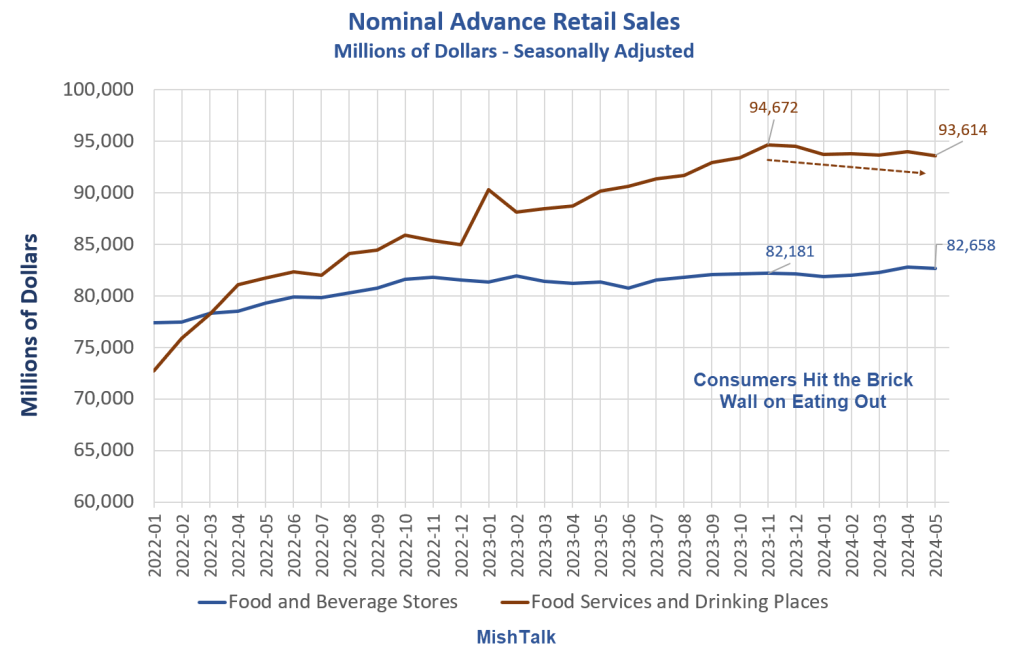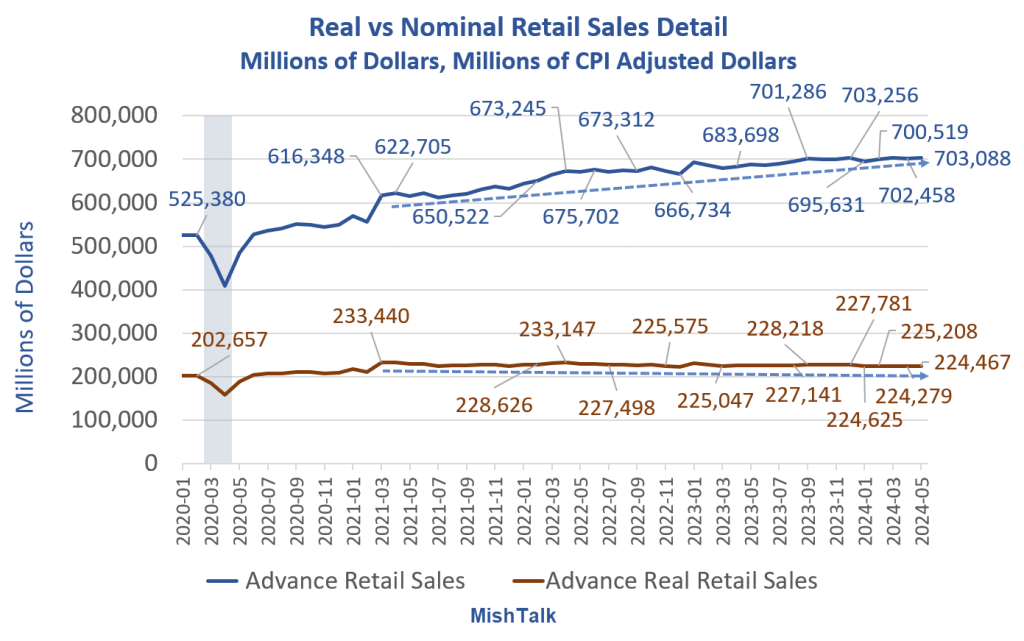Still other signs of consumer exhaustion are evident in the tactics used by McDonalds, Starbucks and other chains to woo customers who were holding back in the face of rising prices.

Free fries on Friday and $5 meal deal
Quartz reports that McDonalds is introducing free fries on Fridays to win back inflation-weary customers
McDonald’s announced Thursday that customers who spend at least $1 on Friday will receive free fries with their order, part of its effort to win back customers spurned by inflation.
“We heard our fans loud and clear: They expect even greater value from us, and this summer, that’s exactly what they’ll get,” Joe Erlinger, president of McDonald’s USA, said in a statement announcing the ‘initiative.
The Chicago-based fast food giant said the fries deal was only available to customers with the free-to-download McDonald’s app and would continue through the end of 2024.
It also announced that its much-publicized $5 deal would begin June 25, allowing customers to order small fries, a 4-piece Chicken McNugget, a small soda and choose between a McDouble or McChicken sandwich for just $5. This deal is expected to run through the summer in select locations.
Price wars
Also note the race to cut prices by Amazon, Walmart and major retailers
Amazon, Walmart, Target and others are all battling it out with discounted deals — and with each markdown, they hope their offer will be the one that wins over inflation-weary consumers. Although some retailers say they are lowering prices to offer deals to shoppers, their efforts clearly align with businesses’ needs to offset falling sales while inflation remains high. In recent weeks, a flurry of quarterly earnings reports and other company announcements have underscored how bargain-hunting customers are and how quickly retailers are moving.
“Retailers respond when consumer confidence appears to be reaching a tipping point,” said Jerry Sheldon, vice president of technology at market research firm IHL Group, referring to the impact of inflation on families. American. “The whole tipping point between supply, demand and cost sensitivity seems quite fragile, and no retailer wants to position itself as a price outlier relative to its self-defined peer group. »
Wait a second. Haven’t economists told us that wages are rising faster than prices? If so, why don’t consumers have more to spend?
Starbucks woos customers with major deals
And for the first time in years, Starbucks is wooing customers with major deals
In an attempt to replenish dwindling customer numbers, Starbucks is now offering a selection of special deals – a promotion the popular coffee chain has avoided for decades.
The Seattle-based operator is currently offering several promotions, including discounts, buy-one-get-one-free deals, and big-ticket perks for loyal customers.
Starbucks has long marketed itself as a premium coffee chain, although its prices tend to be high, which hasn’t been helped by high inflation in the United States – which has led to more and more Americans choose to eat at home or give up special treats.
A large Caramel Frappuccino is typically listed at around $5.65 on the chain’s menu, although a single iced coffee with additional syrups and foams can cost around $10 at full price.
According to Starbucks, its traffic fell 7% in the quarter ended March 31 from a year earlier, the biggest quarterly decline since at least 2010. Its active loyalty rewards users fell by 1.5 million between December 31 and March 31.
Earlier this month, for the first time in more than a decade, the chain began offering coffee and breakfast food bundles starting at $5. “50% off a drink. It’s in progress,” Starbucks said in a recent email to customers. “Keep checking the app all summer long for more upcoming deals.”
A $5 meal deal at Starbucks too, imagine that. I can’t comment on the meal deals at Starbucks because I’ve never been there.
However, I can ask: how many people agree with me that McNuggets are inedible pieces of fried fat?
Back at Starbucks, even if I drank coffee, I wouldn’t pay $10 for it.
McRib Flashback
On February 2, 2013, I commented Yum! The McRib is back, get yours today (after you find out what’s inside); The secret is in the sauce!
McDonald’s McRib is famous in some circles for using what’s known as “restructured meat” technology. Since McDonald’s knows that you will never eat pork heart, tongue or stomach on your plate, they instead decided to grind these ingredients and put them in the shape of a typical rib. This way, consumers won’t know what they are putting in their mouths. As Chicago Mag reported, the innovator of this technology put it well in 1995:
“Most people would be extremely unhappy if they were served heart or tongue on a plate… but when flaked into a restructured product, it loses its identity. Products such as tripes, hearts and scalded stomachs…”
In other words, it’s not actually a coast. Rather, it is a combination of unwanted animal waste processed in large facilities and “restructured” into the form of a rib. Then, 70 additives, chemicals, fillers and GMO ingredients later, you have a “meat” product that tastes like ribs.
I sure hope this whets your appetite, because as we all know, “Parts is Parts”.
By the way, I have no idea what Wendy’s did to their chicken sandwich, but whatever it was, they ruined it. The new dough tastes like Elmer’s glue.
This happened in 2020 when it replaced the Homestyle Chicken Sandwich with the Classic Chicken Sandwich. But aside from the now inedible coating, at least a Wendy’s chicken sandwich is still part of it.
Olive Garden Breadsticks Highlight Financial Stress on America’s Middle Class
In case you missed it, please see my post from June 20, Olive Garden Breadsticks Highlight Financial Stress on America’s Middle Class
Traffic at Olive Garden is up 3.9 percent, but same-store sales are down 1.5 percent. Do people stock up on unlimited breadsticks? Drink less wine?
Retail sales were very weak in May, given negative revisions

On June 18, I commented Retail sales were very weak in May, given negative revisions
If anyone tells you the consumer is strong, have them read this article. The strong consumer is just a mirage of inflation.
Discretionary spending
All the articles in this article have one thing in common. This is purely discretionary spending.
Consumers are under strain and this is the first, if not the only thing they can cut back on.